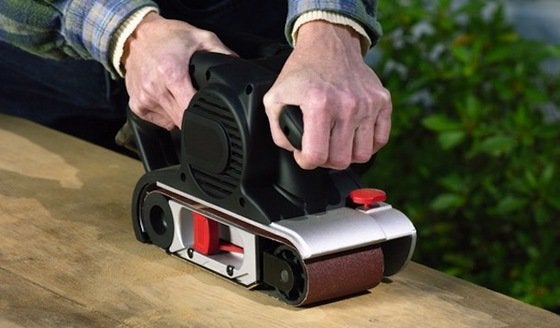How Do You Get a Double Black Belt
Belt Sander
Powered sanders can help you get your work done quickly.

Photo: build.com
The belt sander always seems to be in a hurry. When fitted with a coarse paper, it will sand away dense layers of paint and smooth rough surfaces at a surprisingly fast rate. Like any tough tool, however, it must be handled with appropriate care. The risks it poses are less to the user than to the workpiece, as it can quickly sand away large areas, particularly if left stationary in one area.
The belt sander has two cylindrical drums around which a closed loop of abrasive paper travels continuously. One drum is driven bv an electric motor, the other is spring-loaded to maintain tension on the belt. The belt sander is best equipped to smooth flat surfaces and the edges of workpieces cut along the grain. Most models on the market today have built-in dust collectors, an especially handy feature in a tool that generates as much dust as this one can. Variable speed features are also useful, especially when you wish to do finer work.
Belt sanders are sold as portable and as benchtop models. The former is hand-held, and presented to the work; a benchtop machine is fixed in place and workpieces are brought to its sanding surface. Both are valuable tools, but you will need to consider the nature of the work you want to do with a belt sander before deciding upon one or the other. If both seem necessary, sanding stands and fences can be purchased to convert some portable belt sanders into stationary models. Another option is a combination belt and disk sander.
Stationary Belt Sander. This tool is mounted on a tabletop. If you have an appropriate space, fix it to the surface; if not, some models come with stands that allow the tool to be quickly set in place (and just as quickly removed).
The top, horizontal surface of the benchtop belt sander is used. If the workpiece is shorter than the top of the belt, a fence is set over one drum to function as a stop, allowing the workpiece to rest in a stationary position as the belt spins beneath it. Work the piece from side to side so that the belt will wear evenly.
For smoothing end grain, the tool can be repositioned so that the working surface is vertical.
The most common belt size on home workshop stationary belt sanders is four inches wide by three feet long. Larger machines take six-inch by forty-eight-inch belts or even larger ones.
Portable Belt Sander. The basic elements are the same: a belt, two drums, a motor, and a switch. While the stationary belt sander is designed to be fixed in place in the workshop, the portable belt sander can be taken just about anywhere an extension cord can reach.
Rather than having the workpiece presented to it, the portable belt sander is generally presented to the surface to be sanded. This may be a board clamped to a benchtop, or the benchtop itself. Or surfaces in situ, such as architectural elements still in place.
One task in the cabinetmaker's shop for which the belt sander is the right tool is removing glue lines and making joints flush on facers (the front-facing vertical and horizontal elements that frame doors and drawers). Final smoothing is then done with a finish sander.
The portable belt sander is a two-handed tool, so the workpiece must be securely located. When the machine is turned on, the belt should not be in contact with the work.
Once the machine has reached its full speed, it is lowered gently onto the workpiece; touch down with the rear of the belt first. Unless you are trying to remove material from the surface rapidly, the weight of the machine will probably provide all the force required, so pressing down on the sander isn't usually necessary.
Sand with the grain. For leveling an uneven surface, you may sand diagonally across the grain, but a follow-up step will then be required, using fine paper parallel with the grain. This will remove the scratches produced by the diagonal sanding.
How Do You Get a Double Black Belt
Source: https://www.bobvila.com/articles/2142-belt-sander/